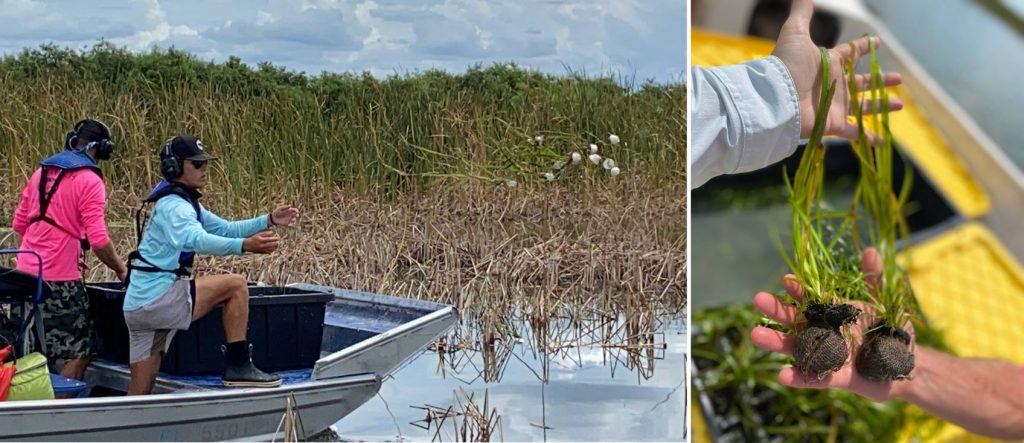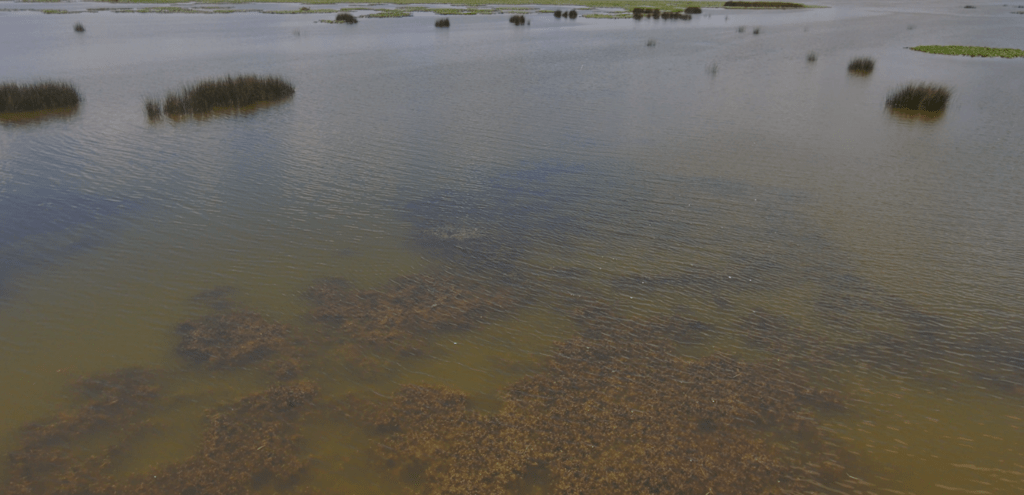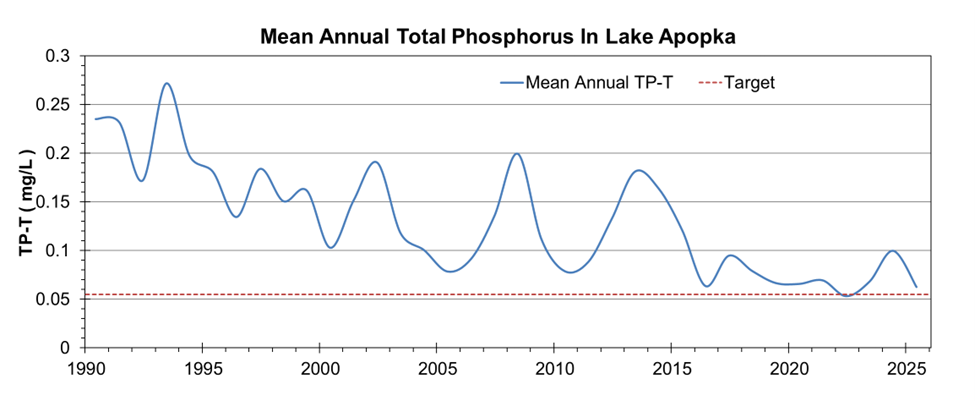Lake Apopka
Updated on 10/30/2025
Lake Apopka, the headwaters of the Ocklawaha Chain of Lakes, has undergone a transformation over the past few decades. Since the 1980s, the District and its partners have worked to improve the lake’s water quality and habitat, achieving significant improvements.
In 1994, there was no submerged aquatic vegetation (SAV) in Lake Apopka. As a result of the District’s restoration efforts, the 2024 survey found visible native SAV around 95% of the lake’s shoreline. More importantly, District staff have observed much of the SAV flowering. Flowering is important for two reasons: first, it is an indicator of good plant health, and second, the seeds provide for natural expansion of this important habitat. The return and continuing expansion of SAV indicates that water quality and clarity are improving. Native eelgrass and pondweed are now expanding into the lake’s open water areas, another promising sign for the ecosystem’s recovery. The increase in native SAV is critical, as it was both a predicted outcome of water quality improvements, and it provides critical sustainable habitat for fish and wildlife.
The lake’s improving health is not just good news for nature—it’s also great for anglers. Recent fishing tournaments in the Upper Ocklawaha River Basin Chain of Lakes, including the February 2025 Bass Pro Tour Suzuki Marine Stage 2, have included Lake Apopka as a tournament lake. Additionally, the Florida Fish and Wildlife Conservation Commission (FWC) has documented a major increase in fishing activity in the lake. Bass caught from the lake have been impressive in size and abundance, making it a popular destination for many anglers.
Restoration in Action:
The restoration of Lake Apopka has focused on a multipronged approach: a “diet” to reduce phosphorus entering the lake, “exercise” to remove phosphorus already in the water and “physical therapy” to help the lake cycle its nutrients.
Phosphorus Diet:
- A significant milestone occurred in 1996 when the state legislature directed the District to purchase farms on the lake’s north shore. These farms, originally floodplain marshes (wetlands) before being drained and diked for agricultural production in the 1940s, were a major source of phosphorus fueling algal blooms, which shaded the lake’s SAV. As the SAV disappeared, the historic bass population collapsed, as did the dozens of fish camps which once lined the lake’s shores.
- Key to reducing phosphorus loading from the north shore was restoring the area’s wetlands to reduce the volume of phosphorus laden water entering the lake. Now, discharges can be treated to inactivate phosphorus, and in 2003 the passage of the Lake Apopka Stormwater Rule enhanced the lake’s diet to the entire watershed.
Phosphorus Exercise:
- Efforts to remove phosphorus already in the lake include the annual rough fish harvest focused on gizzard shad. Harvesting of gizzard shad has been an important factor in the improvement of water quality, with typically 750,000 pounds of shad removed annually. Since 1993, the shad removal equates to more than 274,000 pounds of phosphorus removed from the lake. Click here for more information.
- The Marsh Flow-Way is a 760-acre filter marsh that continuously removes algae, suspended solids, and nutrients from the lake’s water. Located in the southwest corner of the North Shore, the Marsh Flow-Way began operation in 2003 and filters about 30% of the lake’s volume each year. The stored solids are retained in the marsh’s soils, and the treated, clearer water is returned to the lake. Since operation began in 2003, more than 76,500 tons of total suspended solids and 37.5 tons of total phosphorus have been removed from the lake. Click here for additional information.
Physical Therapy:
- As the water in Lake Apopka got clearer, SAV started growing again from the seedbank (seeds stored in the lake’s soil) showing that the water was clear enough to support plant life. SAV absorbs phosphorous from the water and the lake’s sediments. When there are large dense areas of SAV, they help clear the water by trapping suspended particles and stabilizing the lake bottom. The plants use the nutrients to grow, and as more plants grow, the water gets clearer, and more phosphorous is removed. The District, with FWC, Florida Department of Environmental Protection (DEP), and legislative support, began planting native SAV to accelerate the lake’s recovery of this critical habitat.
The combined effect of diet, exercise, and physical therapy has led to a dramatic improvement in water quality. Since the late 1980s, phosphorus concentrations have declined 67% and water clarity increased by 66% as of June 2025. In 2022, the annual average phosphorus concentration was below the target concentration for the first time. Phosphorus concentrations have generally declined over time, with occasional increases during periods of low water levels. Between 2023 and much of 2024, dry weather caused the lake to fall below its normal levels, resulting in elevated phosphorus concentrations. Rainfall from Hurricane Milton restored Lake Apopka’s water levels to within the regulated range, leading to a decline in phosphorus concentrations.
This doesn’t mean the District’s work is done, but it is an important milestone in the lake’s recovery. The return of clearer water allowed more sunlight into the water column, triggering the regrowth of SAV, which had been missing for 50 years, and the critical bass habitat needed for recovering sportfish populations.
Ongoing projects:
- To further restrict the phosphorus diet, the District is implementing a series of projects to improve its
ability to manage water on the North Shore’s recovering wetlands. Recent work completed by September 2025
included repairing internal levees, cleaning debris and muck from major canals, and regrading the Lake Apopka
Wildlife Drive for safer and smoother access. Additional projects scheduled for completion by December 2025
include:- Upgrading pump stations for remote operation.
- Replacing all alum tanks and upgrading alum pump systems across all pump stations.
- A Nutrient Reduction Feasibility Study will be conducted in fiscal year 2025-2026 to look at potential projects
to further reduce phosphorus in Lake Apopka and the Upper Ocklawaha River Basin Chain of Lakes. - The District is expanding its physical therapy work to accelerate the recovery of native SAV in Lake Apopka by
conducting additional plantings using District, FWC and legislative resources:- Planting native floating-leaved aquatic lilies and lotus. Recently, the District planted 28,382 lilies
and lotus to provide submerged habitat on more than 10 acres of the lake. This project was in
partnership with the DEP. The District is considering planting more acreage of floating-leaved aquatic
lilies and lotus. - Planting native SAV like eelgrass and Illinois pondweed. In coordination with our partners, DEP and FWC,
174 acres of SAV (880,039 plants of eelgrass and Illinois pondweed) have been planted in Lake Apopka
since 2021. Future funding and SAV plantings are expected.
- Planting native floating-leaved aquatic lilies and lotus. Recently, the District planted 28,382 lilies


Recreation improvements:
- The District is enhancing wetland habitat and has opened a new recreation area on the portion of the North Shore west of the Apopka-Beauclair Canal. This includes invasive plant treatments, and construction of a new recreation site that will allow permitted access to a new dedicated parking area and boat launch for users who want to launch a canoe or kayak to explore the West Marsh. The District worked with FWC to open permit-based waterfowl hunting and catch and release fishing opportunities. Details on this new opportunity are available at: Recreational day-use permits – SJRWMD.
- The District and Orange Audubon celebrated the 10th anniversary of the Lake Apopka Wildlife Drive on May 4, 2025. This milestone marks a decade of conservation and public engagement in this significant wetland restoration project. Thanks to ongoing efforts to restore the North Shore wetlands, wildlife, particularly birds, have responded with remarkable increases in both numbers and diversity. Today, the North Shore is recognized as one of Florida’s premier birding destinations and an e-bird hotspot, with 377 different bird species recorded on the property, highlighting the success of habitat restoration and its importance for biodiversity.
- The District is designing a dredging project in collaboration with the city of Winter Garden on the south side of Lake Apopka near the Newton Park Boat Ramp. The project’s goal is to improve boating access from the boat ramp to deeper parts of the lake.
Ongoing challenges:
While the lake’s native SAV is flourishing, invasive hydrilla has also expanded rapidly. The District and FWC conducted large-scale hydrilla treatments in 2023 and 2024 successfully returning the cover of this invasive species to the manageable levels it had occupied for years. Legislative support has been crucial in funding these efforts. Management efforts are focused on maintaining hydrilla cover to low levels, which can be effectively addressed through small spot treatments by FWC. These efforts do not negatively affect the native SAV species and provide them with the opportunity to colonize and grow.


